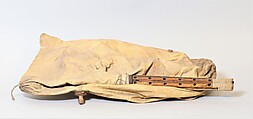Ney-Anbān/Habbān
Not on view
The ney-anbān, or neyhambune, is a Persian bagpipe, most commonly found in Bushehr, Iran. A similar instrument is found across the Persian Gulf in countries such as Kuwait, Saudi Arabia, Bahrain, Qatar, the United Arab Emirates and Oman. It has a variety of names across the region, including habbān and jirba. The instrument is formed of a goat-skin bag, with an insufflation pipe inserted in one foreleg and a double melodic pipe in the other foreleg. The neck of the animal is tied and often decorated with a tasseled rope that dangles behind the player’s shoulder as they play.
This instrument has a double melodic pipe that is on the larger side (28cm long). The fingerholes are equidistant and placed far apart, which requires large hands to play with ease. The melodic pipes are fitted into a wooden sleeve and secured with wax. The base of the melodic pipes is wrapped with thick string, both around the pipes and the yoke. The neck of the animal is internally tied; from the knot emerges a small length of pleated string that might indicate that some decorative element might have been attached to it prior to its accession by the museum in the late 19th century.
The bagpipe has a long history in Iran; the celebrated miniaturist Riza ‘Abbasi (1560/70-1635) produced a rare illustration of a ney-anbān or habbān player from the early 1600s. Subsequent mentions of the ney-anbān in Southern Iran comes from European travelers such as Ousely (1819) and Dubeux (1841).
In Bushehr, the ney-anbān is associated to the fisherman community, and is taken out at sea to entertain the fishermen as they work. It is closely associated with the bandari musical tradition, and is accompanied by a drum and a singer (Nikzat 2018:2). A larger version of the instrument, called the habbān, is used by Arab-speaking communities and played with two drums at festive occasions such as weddings and curcumcisions (ibid.). The bagpipe is also found in other Iranian regions, such as Hosmozgan and Khuzestan. In Kuwait, the bagpipe is often associated to the Iranian minority (Rovsing and Wegner 2001). Across the Persian Gulf, the bagpipe is played with drums. In Bahrain and Kuwait, it is accompanied by four or five drums, and the musicians move in a circular pattern (ibid.).
(Cassandre Balosso-Bardin, 2023)
Technical Description
2 cane chanters 28 cm set into wooden sleeve, no bell, cylindrical bores;
fingerholes R 6/0, L 6/0;
reed inaccessible (typically, cane single reeds, upcut);
turned wooden blowpipe nipple protruding 35mm outside bag, no evidence of valve;
Goat or kidskin bag, with blowpipe tied directly into hole in bag and chanter sleeve serving as stock in one foreleg.
References
Dubeux, Louis, 1841. Histoire et Description de tous les peuples. La Perse. Paris: Firmin Didot Frères Edieturs.
Nikzat, Babak 2018. Constructing identity through revaluation of local musical traditions: A case of bandari music. PhD Thesis, University of Music and Performing Arts Graz.
Olsen, Poul Rovsing, and Ulrich Wegner. "Arabian Gulf." Grove Music Online. 2001; Accessed 13 Apr. 2023. https://www.oxfordmusiconline.com/grovemusic/view/10.1093/gmo/9781561592630.001.0001/omo-9781561592630-e-0000001138.
Ouseley, William, 1819. Travels in various countries of the East, more particularly Persia. London: Rodwell and Martin
Due to rights restrictions, this image cannot be enlarged, viewed at full screen, or downloaded.
This artwork is meant to be viewed from right to left. Scroll left to view more.



